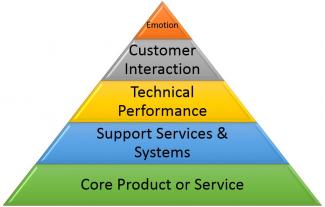Going on the road may have made Simon & Garfunkel “oh, so tired”, but it gave them something most businesses would love to have – a real time customer feedback loop.
The other side of the coin is that it can take a lot of nerve to hear that feedback and keep playing. (Think Bob Dylan going electric at Newport in 1965).
OK, so let’s say we’re now committed to creating Raving Fans. We’ve done our brainstorming, and created an aspirational vision for what our new customer service regime will look like. We’ve found some low hanging fruit in our service delivery model that we are determined to work on.
We now (perhaps belatedly) want to turn our attention to “listening to the customer” and measuring our progress. But where to start, short of hiring a concert hall and inviting them all along?
Commission a Customer Satisfaction Survey, perhaps? Perhaps not. Have you ever agreed to “answer a few questions”, then wasted half an hour of your life enduring an excruciatingly detailed interrogation, before saying “never again”? I have!
If such surveys are rapidly becoming a thing of the past it may be because people like me are no longer prepared to participate, but we can also put it down to the mini-revolution known as NPS, or Net Promoter Score. Fred Reichheld and his team at Bain & Co took the Raving Fan concept to a new level. The philosophy and the end goal are entirely aligned, but they set out to turn the measurement and analysis of customer satisfaction from an artform into a science.
After years of research, they came up with a question that, more than any other, could not just find out how a customer feels today, but predict how they would behave in the future in terms of key metrics like loyalty, spend and profitiability. While it may need to be tweaked for different industries, “the ultimate question” they came up with was simply:
“How likely is it that you would recommend our company/product/service to a friend or colleague?”
It’s beyond the scope of this article to go into the detail (you can consult the experts for that), but based on their answer customers are categorised as Detractors, Passives, or Promoters (think Raving Fans). Passives are put to one side, the percentage of Detractors is subtracted from the percentage of Promoters, and the answer (N=P-D) is the Net Promoter Score, or NPS. Positive is good, negative is bad.
The goal? To have your army of Raving Fans drowning out your handful of bad-mouthers!
If I have one reservation about NPS it’s that it risks becoming a victim of its own success. If you haven’t been asked some version of the question above a hundred times by now you must be living in a different universe to me. But that doesn’t mean the theory isn’t sound. It just means you need to give some careful thought to how you implement it.
Calculating an NPS may make us feel good (or not if it's negative), but it doesn’t achieve anything in isolation. It only becomes a useful tool when we incorporate it into a feedback loop. If we feel we’ve made great strides in improving our customer service but it’s not being reflected in an improved NPS, then either we are focusing on the wrong things, or there are flaws in our measurement regime.
You could employ a busload of highly paid consultants to fully embed NPS into your organisation. Alternatively, you could research the subject, and dip your toe in the NPS water with an in-house implementation. Before going down that path, here are a few traps for young players that I’d advise you to consider:
- Keep it short: As far as possible, stick to “the ultimate question”. Avoid the temptation to tack on supplementary questions that turn it into a customer satisfaction survey by stealth.
We certainly want to know what’s driving Detractors, but keep it simple. Perhaps ask “If there was one thing we could have done differently to get a higher score, what would it have been?”. Alternatively, ask if you have their permission to contact them and discuss their concerns in more depth – and if they agree make sure you follow up.
- Have a clear focus: Are you asking them how they feel about a specific episode, or their overall view of the relationship? There is a place for both, but if we aren’t clear about the context for our question the data we capture will be close to useless.
- Granularity & Frequency: For results to be useful and actionable we want good granularity in our reporting (e.g. department, product, region, salesperson, episode), but we also want to avoid survey fatigue. Finding the balance can be tricky, but if the most common answer to “what could we do differently?” is “stop asking me how you are doing”, then you should take the hint.
- Selection Bias & Gaming Opportunities: If staff have discretion about which customers are surveyed, and feel the NPS results are going to reflect poorly on them, it’s human nature that they’ll skew their surveys towards customers they expect to give a good result.
Similarly, I’ve seen sales staff promising the world in order to get a great NPS score on a sales episode, only for the NPS to dive when the downstream delivery inevitably fails to meet the unrealistic expectations that have been set.
- Customer Selection: While it would be statistically ideal to regularly survey every customer, that often won’t be practical in the real world, and is arguably not even desirable. An alternative to taking a random sample is to focus on your high value customers, as their behaviour will have the most impact on your bottom line.
- Who, How and When to ask: Asking an NPS question in person at the end of an interaction may be easiest to implement, but the customer can feel pressured to give a positive answer. Something less personal (e.g. a voice recording, email or mobile survey) is likely to elicit a more honest response, albeit with a lower response rate.
A final word - Bad Profits and the Golden Rule
If you want to improve customer satisfaction, but all this is a bit overwhelming, here are couple of ways to get the ball rolling:
- Get serious about eliminating "bad profits". We all know what they are. They are the profits that improve a company's balance sheet in the short term, but leave a trail of disgruntled customers (Detractors) in their wake.
Reichheld describes Bad Profits as those earned at the expense of customer relationships. They are generated by extracting value from customers, rather than creating value for customers.
- Once again, if you don't know where to start, just look to the Golden Rule. It's not rocket science. Just treat your customers as you would like to be treated.





